



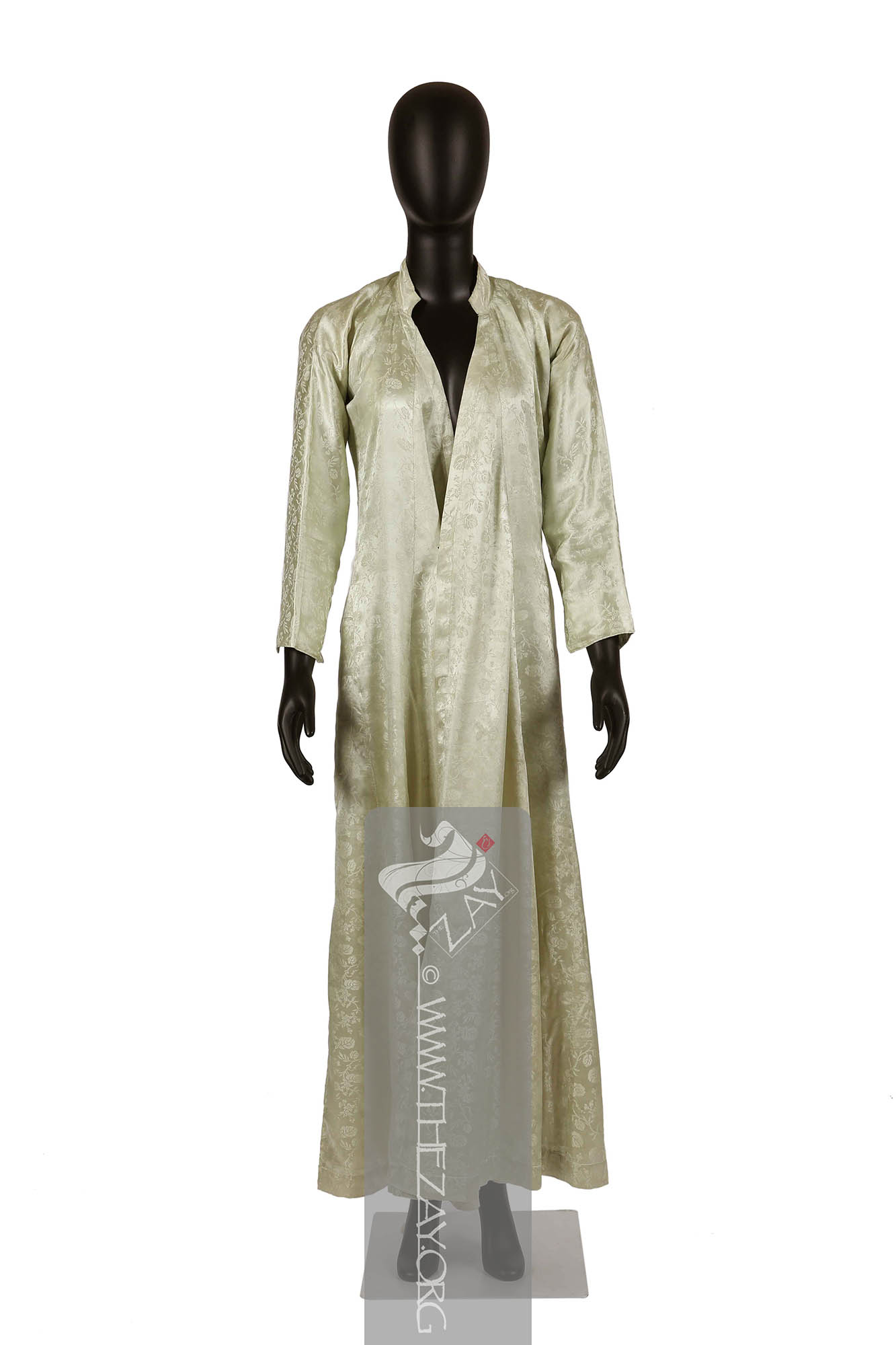
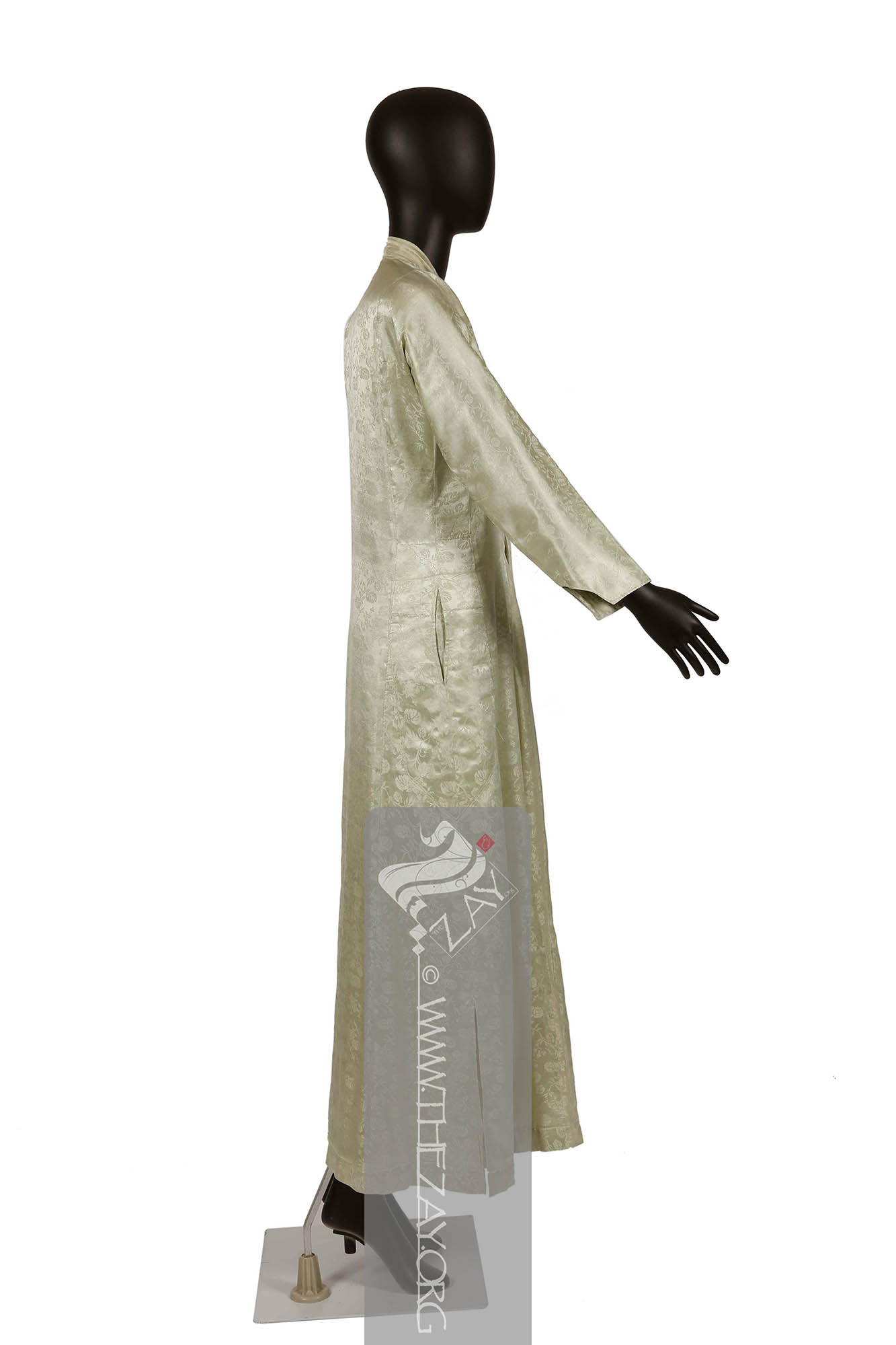
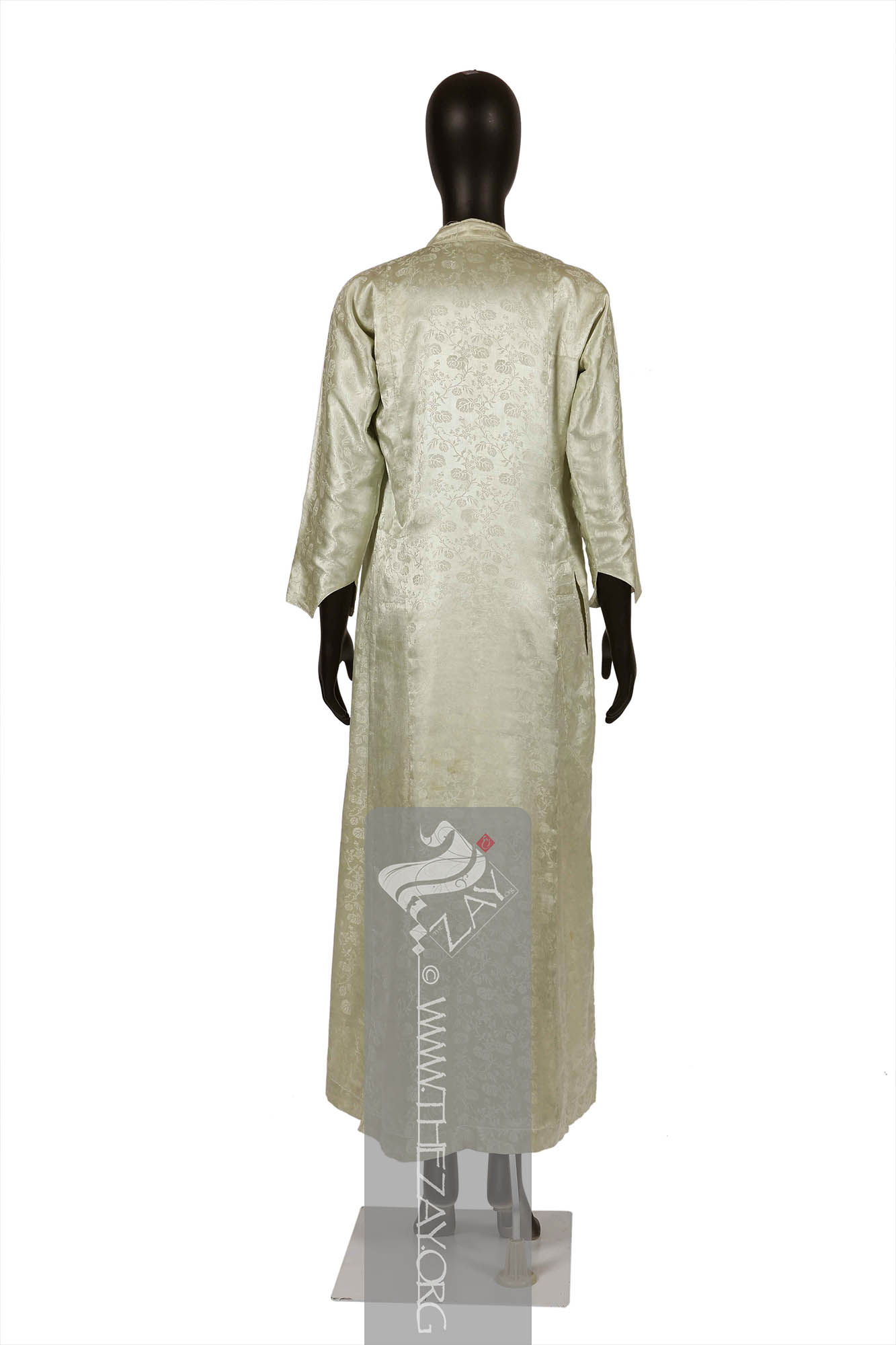
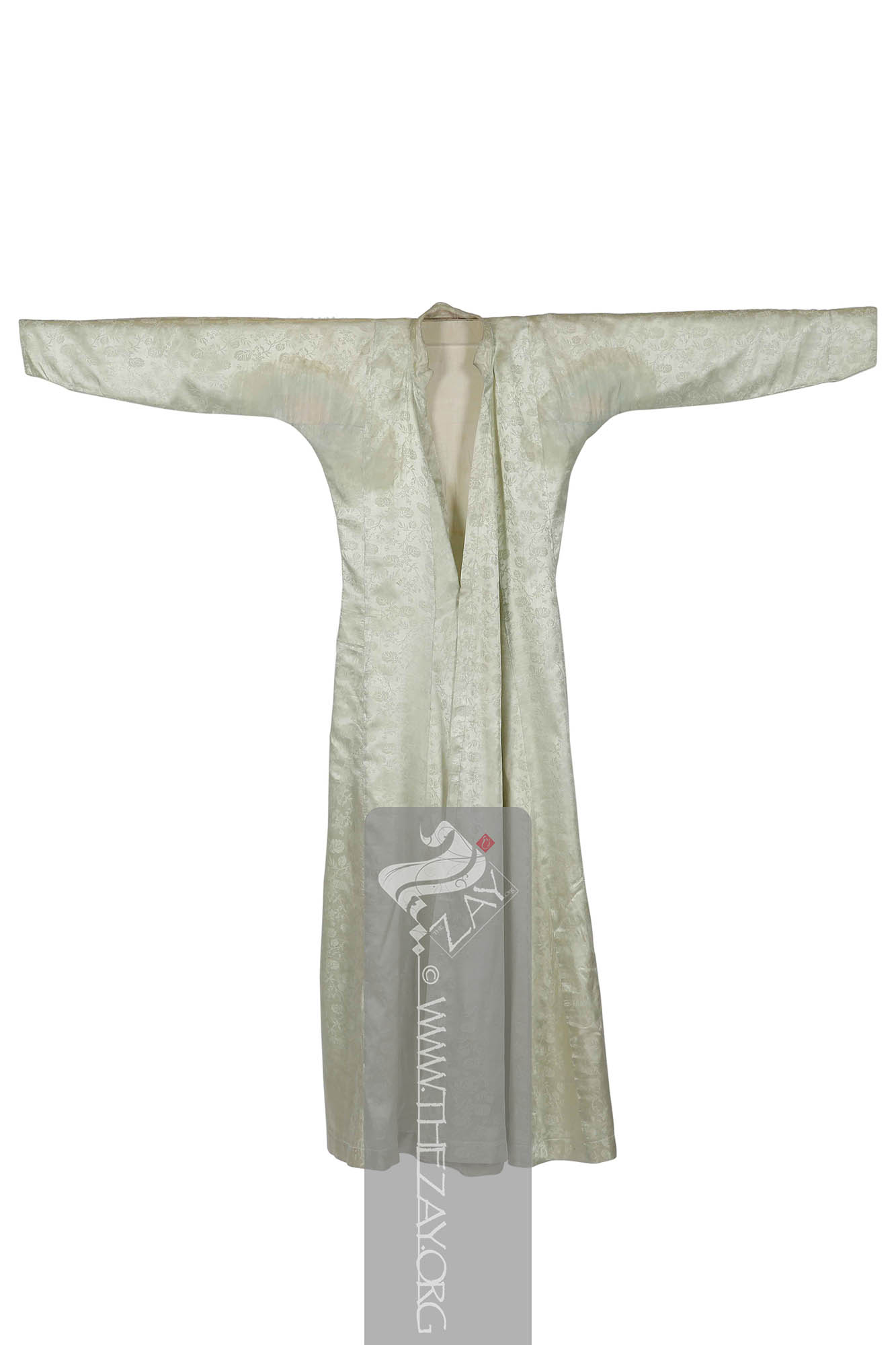


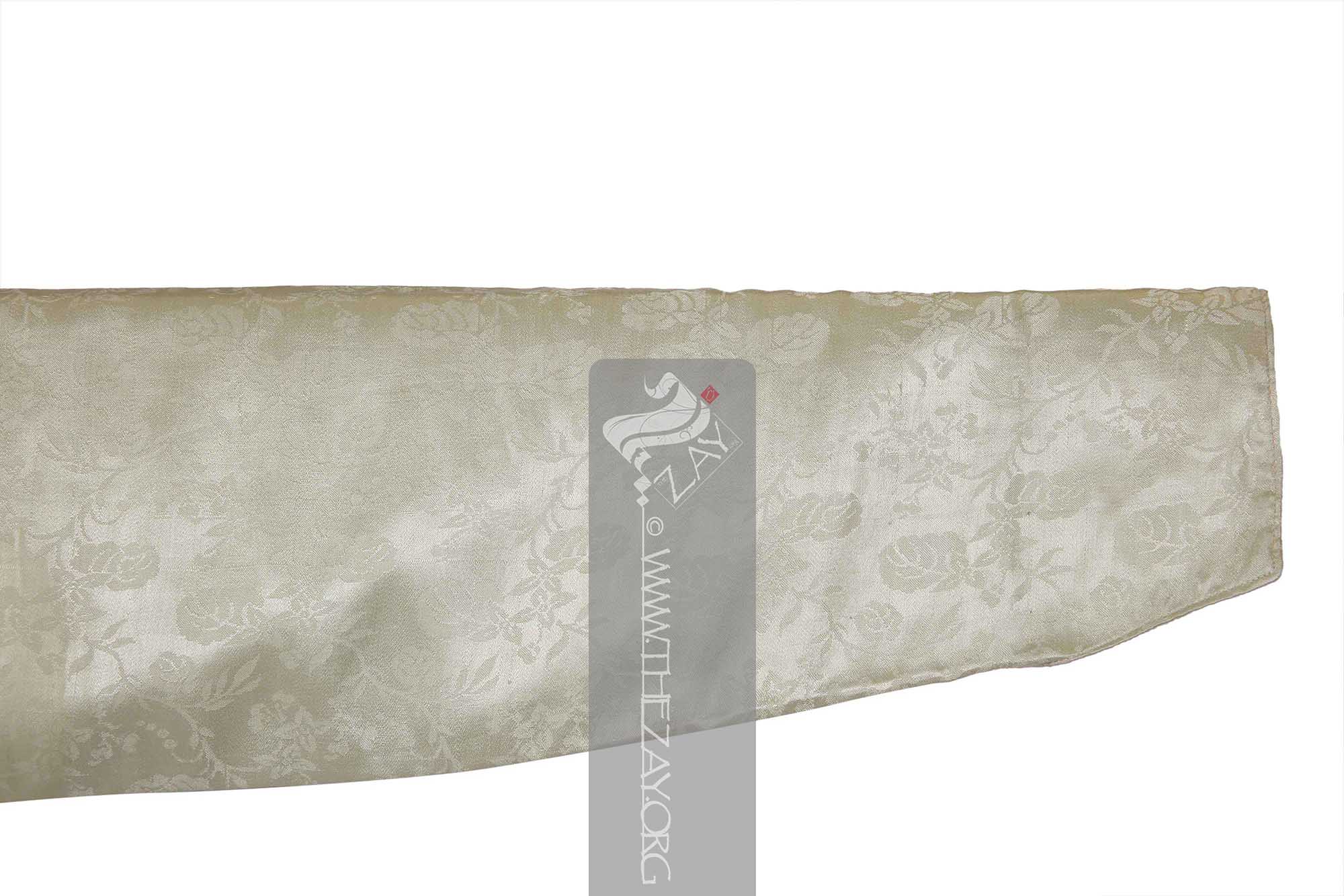
| Local Name | Qumabaz, Sayah |
| Object Category | Overgarment |
| Gender | Female |
| Date of object | c. 20th century |
| Place Of orgin | Iraq |
| Region | Iraq |
| Object Range | Türkiye, Syria, Iraq, Lebanon, Kuwait, Palestine, Jordan, Saudi Arabia, Egypt, Sudan, Cyprus, Bulgaria, Romania, Moldova, Greece, North Macedonia, Croatia, Serbia, Bosnia Herzegovina, Kosovo, Armenia, Azerbaijan, Georgia, et al. |
| Dimensions | Length: 140 cm Width: 141 cm |
| Materials | Silk |
| Technique | Machine Stitched Woven |
| Color | |
| Motif | Floral |
| Provenance | Donated, Alya Anwar Al Qaimaqchi, London 2019 |
| Location | The Zay Zay: (Arabic: costume, Pl. azyaā’), a set of clothes in a style typical of a particular country or historical period. Initiative |
| Status | In Storage |
| ZI number | ZI2019.500701.2 IRAQ |
Object Note
Part of a lot with another item (ZI2019.500701.1 IRAQ) also in the collection.
Object History
This piece was donated to The Zay Zay: (Arabic: costume, Pl. azyaā’), a set of clothes in a style typical of a particular country or historical period. Initiative by Alya Anwar Al Qaimaqchi on behalf of her mother, who inherited it from her mother and bequeathed it to her daughter and granddaughter Mariam Istabraq Al Imam in London in 2019.
Originally owned by Atia Abdul Qadir Pasha Al Khudairi, daughter of Abdul Qadir Pasha Al Khudair, who was one of the pivotal players in the establishment of the Iraqi army in 1921.
Hand crafted in Basra to commemorate the momentous occasion of her father’s bravery Atia wore this at his Medal of Honour ceremony, which was bestowed upon him by Miss Gertrude Bell, Oriental Oriental: (Latin and Late Middle English Adjective: orientalis – From Orient; from Latin (noun): oriri – to rise; and oriors – East), anything of an Eastern origin in relationship to Europe – Asia. The word was first used in the context of territorialization between the late 3rd and early 4th Century CE. Secretary, President of the Baghdad Library (later the Iraq National Library) and founder of the Iraq Museum, on behalf of the British government.
The award served as a recognition of his brave efforts in offering refuge within his home to a group of British women seeking protection from Turkish authorities.
Ma’idah is the mother of Alya and grandmother of Mariam, so 4 generations wore this, and Mariam, at the time we got the dress, had just given birth to a daughter, and we hope one day, once she is old enough, we can get her photographed in it as well. We do not have an image of Atia wearing it, but we have Ma’idah, who sadly has passed away this summer in London, Alya & Mariam wearing the same article.
Object Features
This is a woman’s front open woven silk (damask
Dāmāsk: (Arabic: Damascus – a city in Syria), is a luxurious fabric woven with reversible patterns typically in silk, wool, linen, or cotton. Originating in China, the fabric was perhaps introduced to European traders at Damascus – a major trading post on the Silk Road with a thriving local silk industry. ) robe (qumbaz
Qumbāz: (Arabic; Synonyms: sayah, zubūn, gombaz, yalak), also pronounced ‘umbaz or ‘imbaz is a long front open, unlined, lightweight silk traditional cloak either with quarter or no sleeves fastened at the waist often worn by both men and women in the Levant, Fertile Crescent, and Najd regions. Ṣāyah: (Classical Persian: sāya – shadow; Synonyms: zubūn, qumbāz, gombaz
Gombaz: (Arabic; Synonyms: sayah, zubūn, qumbāz, yalak
Yalak: (Ottoman Turkic: yelek – a hip or waist length vest; from Old Anatolian: yélek – Vest), a short-sleeved waistcoat traditionally worn by men and a long outer robe or tight jacket either sleeveless or short sleeved with a tight bodice traditionally worn by women in the Ottoman controlled Levant. Yalak: (Ottoman Turkic: yelek – a hip or waist length vest; from Old Anatolian: yélek – Vest), a short-sleeved waistcoat traditionally worn by men and a long outer robe or tight jacket either sleeveless or short sleeved with a tight bodice traditionally worn by women in the Ottoman controlled Levant. Qumbāz: (Arabic; Synonyms: sayah, zubūn, gombaz, yalak), also pronounced ‘umbaz or ‘imbaz is a long front open, unlined, lightweight silk traditional cloak either with quarter or no sleeves fastened at the waist often worn by both men and women in the Levant, Fertile Crescent, and Najd regions.
The field of the qumbaz
Qumbāz: (Arabic; Synonyms: sayah, zubūn, gombaz, yalak), also pronounced ‘umbaz or ‘imbaz is a long front open, unlined, lightweight silk traditional cloak either with quarter or no sleeves fastened at the waist often worn by both men and women in the Levant, Fertile Crescent, and Najd regions.
The piece is lined with a thin, plain ivory silk fabric and is completely machine-stitched. A few prominent stains on the lining stand as testament to its usage.
Although constructed as a traditional sayah
Ṣāyah: (Classical Persian: sāya – shadow; Synonyms: zubūn, qumbāz, gombaz
Gombaz: (Arabic; Synonyms: sayah, zubūn, qumbāz, yalak
Yalak: (Ottoman Turkic: yelek – a hip or waist length vest; from Old Anatolian: yélek – Vest), a short-sleeved waistcoat traditionally worn by men and a long outer robe or tight jacket either sleeveless or short sleeved with a tight bodice traditionally worn by women in the Ottoman controlled Levant. Yalak: (Ottoman Turkic: yelek – a hip or waist length vest; from Old Anatolian: yélek – Vest), a short-sleeved waistcoat traditionally worn by men and a long outer robe or tight jacket either sleeveless or short sleeved with a tight bodice traditionally worn by women in the Ottoman controlled Levant. Qumbāz: (Arabic; Synonyms: sayah, zubūn, gombaz, yalak), also pronounced ‘umbaz or ‘imbaz is a long front open, unlined, lightweight silk traditional cloak either with quarter or no sleeves fastened at the waist often worn by both men and women in the Levant, Fertile Crescent, and Najd regions.
Iraq, located south of Türkiye, was a significant Arab territory under the rule of the Ottoman Empire for approximately four centuries. In the northern province of Mosul, which was then under Ottoman rule, the prevalent modes of dress were heavily influenced by the fashion trends originating in Istanbul.
By the 1930s, the elites of Baghdad, as well as other urban Christian and Jewish communities, had fully transitioned from Ottoman attire to European-style clothing.
However, among the urban Muslim elites and middle classes, the shift towards Westernised clothing occurred more gradually, the vestiges of which are seen through pieces like these, which are essentially from a decade or two later.
Links
Charuga: (Possibly Kurdish), a mantle-like embroidered women’s traditional garment from the Qaraqosh region in northern Iraq, traditionally fastened at the shoulder. Historically worn by field workers, it helped conceal dust and dirt, making them less visible during labour, it is a festive garment worn sparingly during festivals and other special occasions.
from Northern Iraq Has Arrived at the TRC!, www.trc-leiden.nl/trc/index.php/en/blog/1378-the-charugaCharuga: (Possibly Kurdish), a mantle-like embroidered women’s traditional garment from the Qaraqosh region in northern Iraq, traditionally fastened at the shoulder. Historically worn by field workers, it helped conceal dust and dirt, making them less visible during labour, it is a festive garment worn sparingly during festivals and other special occasions.
-from-northern-iraq-has-arrvied-at-the-trc. Accessed 29 Jan. 2024.